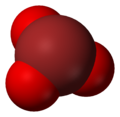 | |||
| |||
 | |||
| Names | |||
|---|---|---|---|
| IUPAC name Potassium bromate | |||
Other names
| |||
| Identifiers | |||
3D model (JSmol) | |||
| ChEBI | |||
| ChEMBL | |||
| ChemSpider | |||
| ECHA InfoCard | 100.028.936 | ||
| EC Number |
| ||
| 15380 | |||
| KEGG | |||
PubChem CID | |||
| RTECS number |
| ||
| UNII | |||
| UN number | 1484 | ||
CompTox Dashboard (EPA) | |||
| |||
| |||
| Properties | |||
| KBrO 3 | |||
| Molar mass | 167.00 g/mol | ||
| Appearance | white crystalline powder | ||
| Density | 3.27 g/cm³ | ||
| Melting point | 350 °C (662 °F; 623 K) | ||
| Boiling point | 370 °C (698 °F; 643 K) (decomposes) | ||
| 3.1 g/100 mL (0 °C) 6.91 g/100 mL (20 °C) 13.3 g/100 mL (40 °C) 49.7 g/100 mL (100 °C) | |||
| Solubility | Insoluble in acetone | ||
| −52.6·10−6 cm³/mol | |||
| Structure | |||
| Rhombohedral | |||
| R3m [1] | |||
a = 6.011, c = 8.152 | |||
| Thermochemistry | |||
Std enthalpy of formation (ΔfH⦵298) | −342.5 kJ/mol | ||
| Hazards | |||
| GHS labelling: | |||
   | |||
| Danger | |||
| H271, H301, H350 | |||
| P201, P202, P210, P220, P221, P264, P270, P280, P281, P283, P301+P310, P306+P360, P308+P313, P321, P330, P370+P378, P371+P380+P375, P405, P501 | |||
| NFPA 704 (fire diamond) | |||
| Flash point | Non-flammable | ||
| Lethal dose or concentration (LD, LC): | |||
LD50 (median dose) | 157 mg/kg (oral, rat) [2] | ||
| Safety data sheet (SDS) | "ICSC 1115". | ||
| Related compounds | |||
Other anions | Potassium chlorate Potassium iodate | ||
Other cations | Sodium bromate Calcium bromate | ||
Except where otherwise noted, data are given for materials in their standard state (at 25 °C [77 °F], 100 kPa). | |||
Potassium bromate (KBrO
3) is a bromate of potassium and takes the form of white crystals or powder. It is a strong oxidizing agent.




